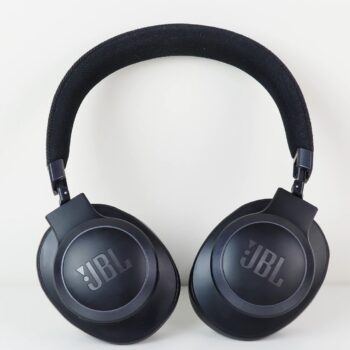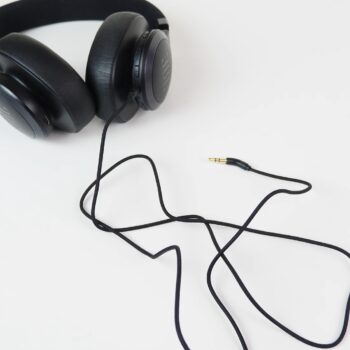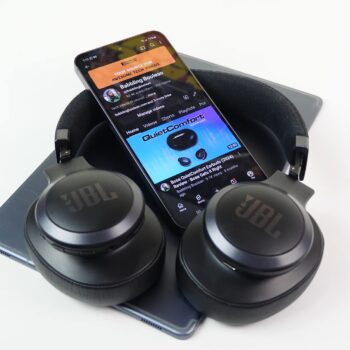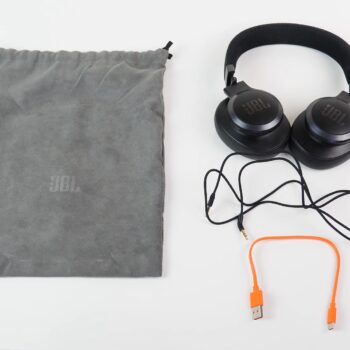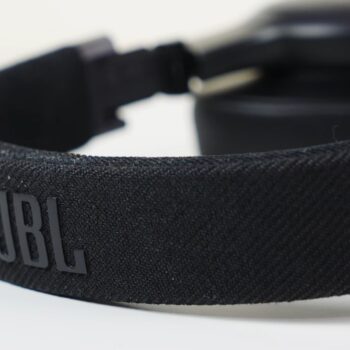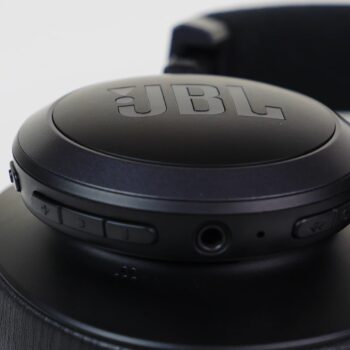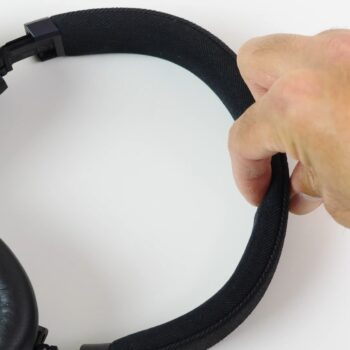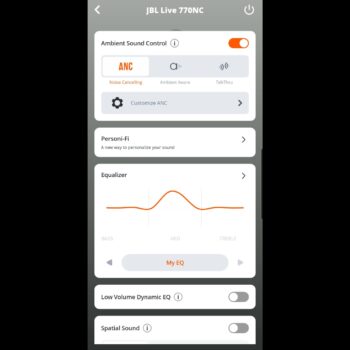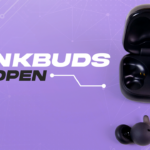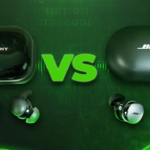Welcome to a review of JBL Live 770NC noise-cancelling over the ear headphones. Let’s dive straight into the review.
Price
Starting with the price, it’s $299 in Canada and $109 in the US. This puts it at the top of mid-tier priced headphones, so I expect mid-tier performance, but not comparing it to something $100 cheaper in Canada.
Connectivity
It supports wireless and wired connections. The auxiliary port is on the right ear cup. You can use the headphones wired while the battery is dead. Interestingly, with a wired connection and battery, you can use active noise cancelling (ANC).
The auxiliary cable is 47 inches long, with 3.5mm ends, one with a J-angle. Note: You can’t use the headphones while recharging.
For wireless, it uses Bluetooth 5.3. JBL’s documentation doesn’t list the range, but while I was walking on the second floor of my house, I got about 45ft with walls in between. So, range is excellent.
It supports dual connectivity: you can connect to two devices at once. If your phone rings, it pauses content on the other device to let you quickly answer the call.
JBL doesn’t specify the number of devices it can remember, but I managed three, which is usually enough.
Accessories
The accessories are disappointing. The travel case is just a soft pouch. At this price, it should be a hard case.
Included accessories are the auxiliary cable and an 8-inch USB-A to USB-C cable (not pure USB-C). There’s no power adapter; you’ll need your phone adapter or computer.
Design & Comfort
For design and comfort, the left side is fine, but the right side is crowded with all the controls and the oversized JBL logo, making it look cluttered.
The headband fabric looks nice but is hard to clean and attracts dust. This was also an issue in the JBL Live 670NC. The fabric traps dust, requiring tedious cleaning. There’s no info on dust or water resistance, so washing might damage the headphones.
So, you’re stuck with potentially dusty headphones. Imagine leaving them on your desk at work, accumulating dust and looking dirty. Picture your boss, sounding like a wise old sage, scolding you for bringing filth into the office: “A clean body helps a clean soul, yet you lack training to take a shower.” I don’t take showers anyway. So, there you go.
Moving on, the headphones come in various colours: black, sand (yes, it’s called sand), white, and blue. They have a folding design, weighing 256g, which is reasonable. Despite the foldable design, the construction is firm and solid, handling some abuse with no issues.
Comfort-wise, wearing them with and without glasses for three hours was pleasant—no sweaty or hot ears. They are not ideal for workouts, as like all over-ear headphones, your ears will sweat excessively and feel gross.
Comfort features include a flexible headband and thick, soft ear cup cushioning. There’s also headband padding underneath the fabric at the center, so it’s comfortable even if you have little to no hair.
The headband adjusts in notches, and the ear cups rotate forward and back well, but only slightly up and down. It’s enough for comfort, so it gets a pass.
Replacing ear pads is tricky. They’re only available on the JBL UK website, where ironically they’re also out of stock. Finding them from third-party vendors is tough, too. Interestingly, I only found replacements for the JBL Tune 770NC, not the Live 770NC.
For travel comfort, putting the headphones on your shoulders allows comfortable left and right movement, but looking down isn’t great. Rotating the ear cups down helps, making movements comfortable.
Controls
All controls are on the right earcup. From bottom to top, the first button cycles between ANC, transparency, and regular mode. ANC (Active Noise Cancelling) blocks external noise, transparency mode lets you hear your surroundings, and regular mode has no special features.
Next is the Bluetooth pairing button, followed by volume down (holding it goes to the previous track), the middle button for play/pause, answering/hanging up calls, and activating your smartphone assistant. The volume up button (holding it goes to the next track) and a slider control for powering them on and off to complete the controls.
The right earcup is too crowded with buttons. When trying to switch between ANC and transparency mode quickly, I often hit the Bluetooth pairing button by mistake. This is frustrating; that button shouldn’t exist. Instead, JBL should’ve combined Bluetooth pairing with the power control slider. Sliding the power button and holding it for 2-3 seconds should activate pairing mode. The overcrowded buttons lead to frequent miss presses. I also often press the volume up button when aiming for the play/pause button, as the groove indentations aren’t distinct enough.
The surface on the right earcup is also a touch surface control, which allows single-tap play/pause and track skipping. I prefer physical controls and turned this off in the app.
Another disappointment is that pressing and holding the play/pause button is supposed to activate the voice assistant. On my Android device with Google Assistant, it doesn’t work. Even after disconnecting all devices and only connecting my phone, nothing happens. Very disappointing.
However, a nice feature is passive play/pause. Taking off the headphones pauses the content and putting them back on resumes playback automatically. This works well and is uncommon in mid-tier headphones.
Noise Cancelling
Noise cancelling is impressive for the price. It’s closer to premium performance, especially at the lower end of that range.
For low-pitch sounds like bus or plane engines, it works well. You can watch documentaries or listen to podcasts, though you might need to increase the volume. In crowded places it performs well in busy environments like bus or train stations, filtering out some background noise.
Overall, it’s a great travel companion. Once you start playing something, the noise cancelling does a good job. You can adjust ANC levels, though it’s not highly sensitive—I kept it on max.
Transparency mode is useful for talking within ten feet, and it makes surroundings sound natural. You can even hear your footsteps clearly on hard surfaces.
Regular headphone mode is okay; it suppresses some noise, but mainly useful for conserving battery. However, the superb battery life means you might not need to use it.
Sidetone mode is available, allowing you to hear your own voice and surroundings during calls. This feature can be toggled in the app.
Battery
JBL claims 50 hours of battery life with ANC on. I tested and got 56 hours. For regular headphone mode, they claim 65 hours. My testing averaged 87 hours, which is phenomenal.
Recharging takes about three hours, but a one-hour charge provides dozens of hours of use. The USB-C charging port is on the bottom of the left earcup.
Microphone Quality
In a quiet setting, the microphone performs adequately for video conferencing, sounding like a laptop microphone.
In a noisy environment, the microphone does a good job of cancelling out background noise. Upon close inspection, there is a slight hint of voice distortion, but this is only noticeable if you are specifically listening for it. Most people wouldn’t pick up on it.
However, when exposed to wind, the microphone performs poorly. It’s surprising that it works well in quiet and noisy settings but struggles with wind noise. If you plan to use it in windy conditions, expect the call quality to be frustrating for the person on the other end.
Audio Quality
JBL doesn’t list audio codecs, but after connecting it to my device I discovered it supports SBC and AAC, which is typical.
Out of the box, the flat profile slightly leans towards bass. You can adjust and lower this in the equalizer if needed.
The flat profile performs well, with decent sound quality. Adjusting the equalizer revealed impressive results. Increasing the bass caused a rumbling sensation, like a car subwoofer. Songs like “Whatever She Wants” by Bryson Tiller sounded great without distorting the bass or the overall sound signature. The only other headphones to do something like this was the excellent Sony ULT bass focused headphones.
Vocals are well-handled, with the singer’s voice pushed forward, maintaining a balance with the instrumentals. Highs are okay, adding some sharpness and energy, though not outstanding.
Overall, the audio quality is superb, delivering satisfying performance for its price.
Wearing glasses affects bass performance because the glasses poke out of the ear cup cushioning, causing bass leakage. This is common with over-ear headphones. Mids and highs aren’t impacted much by wearing glasses.
Software
In the app, you can adjust ANC levels or turn it off completely. Personal-Fi tries to create a customized equalizer setting, but I prefer manual adjustments. The low-volume dynamic EQ boosts highs and lows to maintain audio fidelity, though I noticed no difference same with spatial audio.
You can customize touch controls such as turning off the touch surface and even adjust which modes to cycle between for the ANC button. Voice Aware (sidetone mode) lets you hear your surroundings during calls and you can deactivate this function if you wish. There is a native functionality for music or video listening but in my testing it made no noticeable difference, so I ignored it.
The volume limiter is a nice feature but limits volume too much, so I leave it off. Other features include quick start guides and firmware updates.
Conclusion
I’m pleased yet disappointed. These headphones are great for the higher end of the mid-tier price range and worth looking into. They have fantastic ANC, great audio quality, and comfort—some of the hardest features to achieve.
However, some decisions were odd and could have been avoided. Such as crowded controls, headband fabric, etc. Despite that, they’re still worth checking out.
Score:
7.5/10
Pros:
-Auxiliary connection
-Wired listening with dead battery
-ANC in wired mode
-Bluetooth range
-Dual connect
-Multi-device memory
-Just okay appearance
-Build strength
-Comfortable
-Colour options
-Auto play/pause
-ANC performance
-Transparency performance
-Battery
-USB-C charging port
-Just okay microphone
-Okay noise cancelling microphone
-Audio quality
-App
-Sidetone option
Cons:
-Soft carrying case
-USB-A to USB-C cable
-Retains dust
-Crowded controls
-Phone assistant issues
-Microphone wind noise blocking

